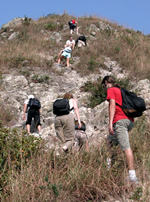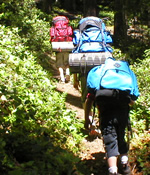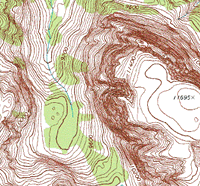
health
Mountaineer Rest Step Helps You Make the Grade
 If you like to hike, you must already know that going up even a mild grade can tire your legs out quite rapidly. What you may not know is the reason why. Blame it on lactic acid.
If you like to hike, you must already know that going up even a mild grade can tire your legs out quite rapidly. What you may not know is the reason why. Blame it on lactic acid.
If normal circulating blood flow does not have a chance to carry off built-up amounts of lactic acid, you will begin to feel a burning pain and muscle fatigue. This is especially true when climbing a grade that gives your quadriceps and gluteus maximus a workout. No matter what condition you’re in, these muscles require a steady supply of oxygen, and a steep grade gives them almost no time to get that oxygen and recover.
The solution to the problem is the mountaineer rest step, which I have also heard called the Indian step. I’m guessing here, but maybe Native Americans discovered that if they rested the non-supporting leg, the burning sensation would dissipate. Known for covering tremendous distances while hunting, it would not be surprising if Native Americans exploited this technique in order to beat back the muscle fatigue.
So how do you relax your muscles when climbing a steep grade? Seeing it done is easier than explaining it, but here goes.  As you step forward, you straighten your rear knee and keep all your skeletal weight on the back leg. Your forward foot supports no weight at all, but just rests on the ground, allowing the muscles to relax so that circulating blood will carry away the lactic acid. Then you switch legs, so that the other side gets a chance to stop supporting your weight. When you stop walking and rest, oxygen is restored to the tissue and the lactic acid ends up in your liver where it is converted to glucose. Of course this whole scenario is exacerbated by altitude, which is why the longer and higher you climb, the worse the burning sensation will get, and the less oxygen gets to your muscles.
As you step forward, you straighten your rear knee and keep all your skeletal weight on the back leg. Your forward foot supports no weight at all, but just rests on the ground, allowing the muscles to relax so that circulating blood will carry away the lactic acid. Then you switch legs, so that the other side gets a chance to stop supporting your weight. When you stop walking and rest, oxygen is restored to the tissue and the lactic acid ends up in your liver where it is converted to glucose. Of course this whole scenario is exacerbated by altitude, which is why the longer and higher you climb, the worse the burning sensation will get, and the less oxygen gets to your muscles.
 Bear in mind that you will look like an idiot hiking in this manner. Some people are reminded of an uphill wedding march because of the slow pace and brief hesitation to the stride, but who cares what it looks like if the burning pain disappears. I tried to get my wife to use the technique once, but having been behind me for a few minutes while I was using the rest step, she was unable to stop laughing. Always happy that I can entertain her, I continue to use this rest step. It’s awkward when I first start it, but after a while you build up a rhythm for it and it gets easier. The only drawback is when you hike with someone who is not using it (that’s you, wife), they will need more rest breaks than you do. Still, at the end of the day when you don’t have to fall into bed immobile, it will be worth it.
Bear in mind that you will look like an idiot hiking in this manner. Some people are reminded of an uphill wedding march because of the slow pace and brief hesitation to the stride, but who cares what it looks like if the burning pain disappears. I tried to get my wife to use the technique once, but having been behind me for a few minutes while I was using the rest step, she was unable to stop laughing. Always happy that I can entertain her, I continue to use this rest step. It’s awkward when I first start it, but after a while you build up a rhythm for it and it gets easier. The only drawback is when you hike with someone who is not using it (that’s you, wife), they will need more rest breaks than you do. Still, at the end of the day when you don’t have to fall into bed immobile, it will be worth it.
Jay Harrison is a graphic designer and writer whose work can be seen at DesignConcept. He's written a mystery novel, which therefore makes him a pre-published author.
© 2006-2013 ConceptDesign, Inc. Terms of Use
BoomSpeak - For babyboomers - by babyboomers.